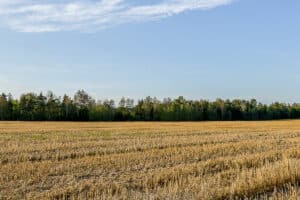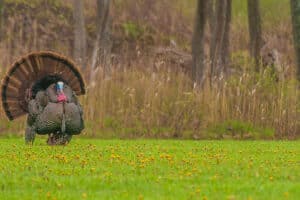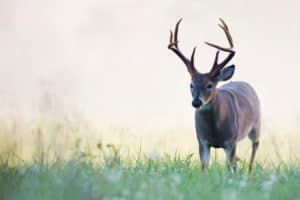The guns of November always herald Thanksgiving.
We are in the middle of rifle season for deer. Muzzle-loading season is behind; other seasons are ahead. But these two weeks are THE BIG DEAL—school kids get time off, businesses shut down and a handful of shiny, out-of-county Hummers wad up outside the Mountain Hideaway.
Here a ka-boom, there a ka-boom, but not everywhere a ka-boom boom.
The hills are not alive with the sound of gunfire, and I wish I heard more.
Why? It’s simple: We have too many deer, particularly too many females—a gender that I generally like a lot.
Unlimited hunting reduced America’s white-tail deer population to about 300,000 in the 1930s. Today, the herd is estimated at about 30 million, and much of our hunting focuses on big bucks with big racks.
Deer have become pests in many places—the countryside, suburbs and cities. They’ve lunched in Central Park and called on the White House. They’re gorgeous, graceful and inspiring; they’re also dangerous, destructive and costly.
They cause an estimated $2 billion in annual damage to forests ($750 million+), crops ($100 million+), landscape vegetation ($250 million+) and vehicles ($1 billion+ in repairs, 1.5 million crashes, 14,000 human injuries). They host ticks that carry Lyme disease.
White-tail deer (Odocoileus virginianus) thrive east of The Rockies on open-and-wooded land, particularly where they become habituated to people and are not hunted. Suburbs provide palatable and nutritious food with no predators. Deer do best on developed land, not old-growth forest. Backyards, golf courses, parks, power-line easements—it’s easy for them to make a living off modern American life.
Deer are too abundant around here for everyone’s good. In my woods, they browse off the defenseless maple, oak and cherry seedlings that my 24-year-old daughter is counting on for her retirement. If you see a browse line about five or six feet high on trees in early spring, it’s a signal that too many deer are competing for too few meals.
I’d guess that we now have as many as 40 to 50 deer per square mile, when 20 or fewer is the better rate from an environmental perspective. Some suburban hot spots count more than 100 head per square mile. Ten to 15 is the estimate for pre-European America.
When Melissa and I moved to tiny, rural Blue Grass more than a quarter-century ago, deer were around, but not plentiful and certainly not underfoot. Today, eight have set up in my back pasture, sleeping in a small patch of scrub woods next door. Next spring, those eight could easily be 20.
Deer are like the Sorcerer’s Apprentice in Goethe’s poem, Der Zauberlehrling. Deer can’t stop copying themselves, just like the magician’s broom can’t stop fetching water into a flooded house.
Left alone, deer will reproduce to the point where they exceed the ability of their habitat to sustain them. Then, they starve. But before that happens, they inflict long-term damage on trees, forest health, plant diversity and ground-dwelling birdlife as they eat everything that’s edible.
Responding to the near disappearance of deer from over-hunting, states began rebuilding their herds before WW II. Hunting seasons were shortened, and “bag limits” — the number killed — were imposed per licensee.
Limiting the doe kill increased herd size. Females can produce as many as 20 offspring over a normal life span and usually have twins.
Today, bag limits should be raised because we have too many deer. Current limits are outdated and dysfunctional. They don’t maintain herds at sustainable levels.
Many hunters, perhaps most, prefer more deer to fewer. A policy that reduces deer populations to sustainable levels would encourage taking more does. From the hunter’s perspective, does are less interesting even though they are better eating.
One out of six Americans — 17 million households — reported having had trouble putting food on the table last year. It seems that government could help in a small way to solve two problems with one policy.
Many communities have programs for hunters to donate deer for processing and then distribution to needy families. State and federal policies could provide tax incentives or even direct payments to hunter-donors. They could also be rewarded with higher bag limits, especially for does.
Hunting for herd control rather than hunting for racks is more effective than most options for reducing deer population. It is not without risks, especially in suburban areas. But the alternatives — habitat management, fences, bioengineering, repellants, etc. — are usually too costly, unwieldy or ineffective.
People who don’t hunt often fear and belittle those who do. They might object to killing animals, or feel funny about shooting Bambi. They are disturbed by gunfire. They don’t like the idea of folks in camo shooting at this and maybe hitting that. Actual experience with sharpshooters and bow hunters culling deer in suburbs seems to show good environmental results, responsible participants and safe operation.
Most hunters obey hunting laws. A few ignore all regulation routinely. And others may be opportunists. But I’ve always felt safer in a circle of armed hunters than just about anywhere else in public. Of course, I’m antlerless.
Still, I must admit that every year some sorry soul ends up in our local court for having shot the Game Warden’s dummy deer out of season. Inevitably, he will confess: “Couldn’t figure it out, judge. The thing didn’t fall after I put the first round into him. Then I put three more in, and he still didn’t drop. Didn’t even quiver; never had that happen before. One helluva buck, I thought at the time. Now I know. Just glad it wasn’t my eyes that were off, or my gun sights.”
The first Thanksgiving was based on deer, not turkey or Pad Thai takeout.
The diners celebrated having made it through a dreadful year. The Wampanoag, who contributed five deer, had lost a majority of their number to the Europeans’ plague. The Pilgrims were down to just over half of their original 102.
Unspecified “wildfowl” were eaten. No account mentions a turkey, a real turkey—the kind that lives in the woods and chews up more like a baseball than a butterball. The first Thanksgiving may have gone cold turkey.
One of the ironies of this odd meal, which has captured our consciousness, is that the folks who were perfectly adapted to life in their native woods were almost wiped out, and those who had not a clue about what they were doing survived and prospered. The Pilgrims attributed this to God’s will, but it’s arguable that guns and germs had quite a bit to do with it.
Over the years, many Americans lost their taste for both game and hunting. In their places, we now have latte and social networking.
Today, venison is five-star restaurant fare, as well as what poor country folks get by on. It deserves an audience between the two.
This Thanksgiving I am grateful for many things. Both my wife and my kid continue to talk to me, more or less regularly. I’m a year older, but not too nicked up.
On Thanksgiving Thursday, I will focus once again on the trimmings and not on the turkey, which, thankfully, is still a bird, of sorts. And I will hope for fewer deer and better times for more people.
This content may not be used or reproduced in any manner whatsoever, in part or in whole, without written permission of LANDTHINK. Use of this content without permission is a violation of federal copyright law. The articles, posts, comments, opinions and information provided by LANDTHINK are for informational and research purposes only and DOES NOT substitute or coincide with the advice of an attorney, accountant, real estate broker or any other licensed real estate professional. LANDTHINK strongly advises visitors and readers to seek their own professional guidance and advice related to buying, investing in or selling real estate.









1 Comment